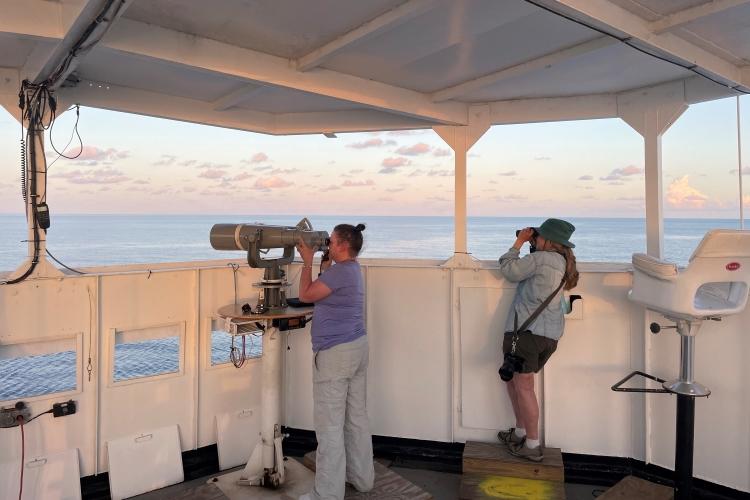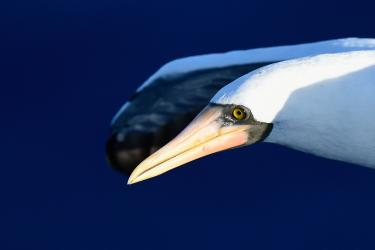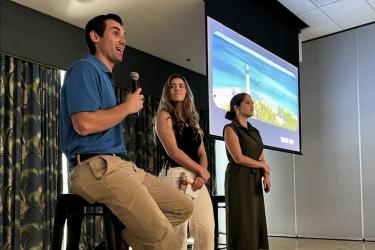The scientists are continuing their work on the extended leg that will complete the 2023 Vessel Surveys For Abundance and Distribution of Marine Mammals and Seabirds project in the Gulf of Mexico. There are three teams on this survey: marine mammal observers, bird scientists, and acousticians. They will work together to gather more crucial information on marine life throughout the Gulf.
The scientists are often asked, “What is life like on the ship?” People are curious about their work schedules, the daily activities aboard the ship, and other unique aspects of working on a science vessel.
Life on the Ship for the Entire Science Crew
The NOAA Ship Gordon Gunter has multiple deck levels with various state rooms (bedrooms). Each room has a desk and can hold up to two people who sleep on a twin bunk bed. Each state room either has its own head (bathroom) or has a suite style head that is shared with one other room. The home design shows call it a Jack-and-Jill bathroom layout.
Around 6:00 a.m., the science crew begins their busy work schedule with a steaming cup of coffee and a hearty breakfast. The stewards (chefs), Margaret and Gregory, wake up even earlier to prepare the team a delicious meal in the morning. Three meals are served each day at consistent times, for about an hour. Once that time is complete the food is stored away or disposed of, so the crew has to get it while it’s hot. Snacks and peanut butter and jelly sandwich supplies are available throughout the day, and the ice cream fridge is a staff favorite.
After breakfast the three teams disperse to their stations. The marine mammal observers head to the flying bridge, bridge wings, or the back lab. The acousticians meet on the stern to deploy the acoustic array and the bird scientists make their way to the flying bridge.
Marine Mammal Observers
When the marine mammal observers are on watch, they have three main goals:
- See any potential marine mammal sighting
- Identify the marine mammal species once sighted
- Count the group size
“We need to get good rest in between our shifts to remain alert because the main objective is to be able to see any potential signs of marine mammals. If we’re too tired to spot them we won’t be able to accomplish the other goals during the survey,” said field chief scientist Tony Martinez.
To ensure effective rest time during the day, the marine mammal visual observer team gets 1 hour on and 1 hour off throughout the day. During the scientists' time off, they enjoy reading a book, taking a nap, getting their steps in, or working on other tasks. The rotation schedule is posted the night before, so that everyone understands their set observing times.
During the daylight hours there are always two teams on watch with two observers per team looking into the distance through the bigeye binoculars. The teams are making continuous 90-degree scans from the front of the bow to each side. When they spot something that might be a marine mammal, the observer gives a verbal cue, which the data recorder, called the Uber, documents. A cue can be a fin, a splash, a blow, a breaching animal, or anything that makes the observer think it may be a marine mammal. Each cue is entered with a measured angle and distance of where it was initially seen. Then the team goes “off effort” to investigate the cue, determine if it is a marine mammal sighting, work through the identification process, and estimate the group size.
Bird Scientists
The bird scientists on this project work as a two-person team. They rotate on and off every hour from sunrise to sunset with the focus on bird identification and flock sizes. The scientists on this leg are Lisa Hug and Jon Andrew with Terra Mar Applied Sciences, contracted by the U.S. Fish and Wildlife Service.
The bird scientists also work from the flying bridge, which is the highest point accessible on the vessel. This allows them to get optimal visibility of the birds with handheld binoculars.
Jon Andrew explained, “I enjoy being out here and working with a teammate. Seeing pelagic birds is always enjoyable. The pelagic birds of the Gulf are not that well understood. These surveys will help increase our understanding of the ecology and distribution of pelagic birds and help in conserving them. During the previous leg we were able to document several large mixed species flocks made up mostly of sooty terns and Audubon’s shearwaters. We are hoping for just as much success on this leg.”
Acousticians
The acousticians spend their days inside the lab on the lower deck to monitor the real-time data streaming in from the towed hydrophone array through a specialized program on the computer. During their shift, they record the real-time acoustic data, monitor spectrograms (visual representations of the sounds) for marine mammal sounds, and take notes about the sounds they hear.
Shannon Merkle, an acoustician on the survey explains, “Jonny Reid and I work shifts that are 2 hours long, with a 2-hour break in between. This leg we have a brand-new array, so we should be able to effectively hear all of the sounds of the marine life in the area.”
End of Day
At the end of the day most of the scientists will step out on deck to watch the sun fall below the horizon. They will generally come together to debrief about the day. The survey remains as routine as possible to maximize its efficiency. Then it’s time to catch up on their favorite TV show, conquer a workout, relax in their state room, or simply enjoy each other’s company and get to know each other.
Meet the Blogger
Ellie Hartman
Ellie Hartman was born and raised in Breckenridge, Colorado. She was a communications intern, research assistant, and marine mammal observer for NOAA's Southeast Science Center. She graduated from Barry University with a Master's of Business Administration and graduated from University of Miami with a Master's of Professional Science in Marine Conservation. Meet Ellie











